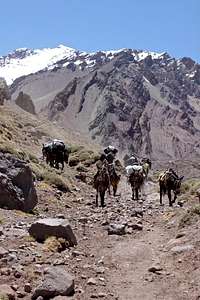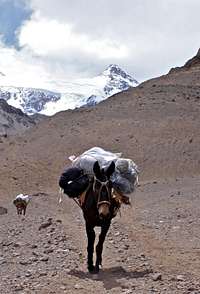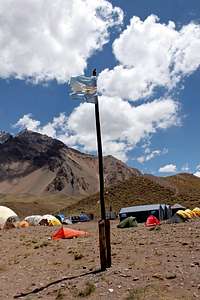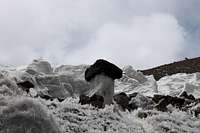-
 10442 Hits
10442 Hits
-
 92.85% Score
92.85% Score
-
 40 Votes
40 Votes
|
|
Hut/Campground |
|---|
Overview
I was originally planning to go via Polish Glacier, but since the conditions of the glacier were bad and my time limited we decided to go via Normal Route. My partner was Corax. We were in and out of park in 8 days, not bad for me not being acclimatized (other than living in Colorado).I described below all the campgrounds along the normal route up Aconcagua. Most people do not sleep in all campgrounds. We spend the night only at Plaza de Mulas and Nido Condores.
Mules
Mules are very common on Aconcagua (and overall in the Andes). Each mule can carry up to 60 kg of gear, divided in 30 kg bags. So, don't pack bags more weighing more than that. Mule company does check the weight. The price varies from company to company. I had one 20 kg bag, and one company was charging 160 US$, then I asked another company and they charged 3$ per kilo. What a difference!I think that treatment of mules on Aconcagua was good, but I still felt sorry for the huge loads they had to carry.
Camps
| Camp | Photo | Elevation | Description |
| Confluencia | 3300 m | Confluencia is only 10 km away from the Horcones Ranger Station, and the elevation gain is 500 meters (1640 feet). The trail is easy to follow, and can be done pretty fast (we hiked it very quickly, 2.5 hrs?). There is a fresh water at the campsite, and a check in station with park rangers, and also a medical station. The campsite is named after the confluence of two river valleys: to your right is the entrance to the route leading to Plaza Francia, base camp for the infamous South Face routes. To the left is the route to Plaza de Mulas. Some people spend 2 nights at Confluencia, and use a day to hike up to Plaza de Francia as an acclimatization trip. | |
| Plaza de Mulas | 4300 m | Again, there is a nice trail between Confluencia and Plaza de Mulas, very easy to follow. Sometimes the trail splits, and it appears like several trails next to each other - in general, in you follow the mule trail, you are on the shortest route. The vegetation above Confluencia quickly disappears, and the Horcones Valley can be very windy. There is a water along the trail (sometimes red colored, but drinkable). You will pass the old destroyed Plaza de Mulas at 4100 m. You supposed to check in upon arrival to the base camp. If you used mule services, you can get an assigned place with the company who delivered your bags. Otherwise, rangers will advise you where to go. There is also a doctor at the basecamp, and you should have your medical check done. I was surprised how many people were hypoxic at that altitude - 4300 m = 14,100 feet. It was not uncommon to have oxygen saturations in low 80s, or even high 70s, and tachycardia with HR with over 120. There is a shower available (did not use it, so did not find out about fee), there are restaurants (again did not use any), and an internet. It was very expensive. I believe like 30$ per 1/2 hr. | |
| Canada | 4900 m | Plaza Canada is about 4900 meters (=16,075 feet), and a common place where cache their stuff, and then come up to sleep. We have not stayed there, we went directly all the way to Nido de Condores, but I jogged there one day from the base camp. The elevation gain between the base camp and Canada is 600 meters (1970 feet), there are many switchback along the trail. I did not see any source of fresh water, but there was snow for melting. Here you start to use your fecal material bags = FM bags. No rangers or medical services here. | |
| Alaska | 5200 m | The trail is pretty obvious from Camp Canada all the way to Nido de Condores. Most people go directly to Nido, 500 meters (1640 feet) elevation gain, but some prefer to set up a camp at 5200 meters =Alaska. Again, we did not stay there. The water was obtained via snow melt. There may not be any tents (I have not noticed any on the way up, but plenty of on the way down. No rangers or medical services available here. | |
| Nido de Condores | 5400 m | It means Condor's Nest, but there are no condors there. 5400 meters =17,715 feet. This place can get very windy, so get your tent well prepared. We did built a nice stone wall around (be careful when picking up rocks, many have sh.t under it). Supposedly, there is a pond, where you can obtain your water. We had snow covered ground, and no pond in sight, so we were melting water. This campsite is pretty large and very spread out. There is a park ranger station there, and sometimes also medical help. The views from here are great. | |
| Berlin | 5900 m | The elevation gain between Nido and Berlin is only 500 meters. My little book says that most parties need between 2-5 hrs to make this distance, but if you are acclimatized, there is no problem to make it in less than 2 hrs. Camp Berlin was lately not much used - we found it very empty. Most people choose to go to Cholera, which is supposedly cleaner. Berlin does not get a morning sun, so it may be colder, and is about 50 meters lower compared to nearby Cholera camp. Again, there are no rangers there. Remember using your FM bags! We did not stay here. We went for the summit directly from Nido, but most people make a higher camp, and attempt the summit either from Berlin or Cholera. The wooden shelters were filled with snow, so do not count on it as an accommodation place. | |
| Cholera | 6000 | Many people now prefer Camp Cholera (also known as White Rocks), which should be more clean than Berlin. We visited Berlin after a snow fall, and it was so empty, only 2 tents, so it appeared to me more clean than Cholera, which had quiet a few tents around. Again, we did not stay here, only visited friends on our way down from Aconcagua. The scenery of this campsite is great. Plenty of rocks around to give you some protection from wind, and it does get an early morning sun. It is also a last good place to start your final push for the summit. It is just slightly higher than Berlin, about 50 to 100 meters difference. |
















